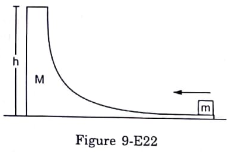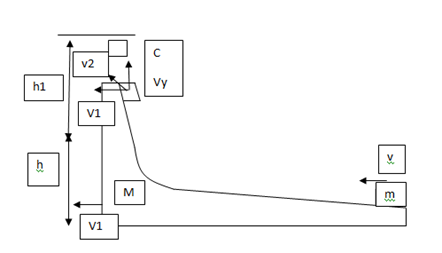Figure (9-E22) shows a small body of mass m placed over a larger mass M whose surface is horizontal near the smaller mass and gradually curves to become vertical. The smaller mass is pushed on the longer one at a speed u and the system is left to itself. Assume that all the surfaces are frictionless. (a) Find the speed of the larger block when the smaller block is sliding on the vertical part. (b) Find the speed of the smaller mass when it breaks off the larger mass at height h. (c) Find the maximum height (from the ground) that the smaller mass ascends. (d) Show that the smaller mass will again land on the bigger one. Find the distance traversed by the bigger block during the time when the smaller block was in its flight under gravity.

Given that the mass m has a given velocity v over the larger mass M.
{a} When the smaller block is travelling on the vertical part, let the velocity of the bigger block be v1 towards left.
From law of conservation of momentum (in horizontal direction)
![]()
![]()

{b}When the smaller block breaks off
Let its resultant velocity is v2.
From law of conservation of energy
![]()
![]() ______ (1)
______ (1)
![]()

{c} Now, the vertical component of the velocity v2 of mass m is given by
![]()
![]()
![]()
![]() _________ (2)
_________ (2)
To find the maximum height (from the ground), let us assume the body rises to a height h1, over and above h.
Now, by work energy principle
![]()
![]() _________ (3)
_________ (3)
So, total height will be
![]()
![]()
![]()
![]()
{d} Because the smaller mass has also got a horizontal component of velocity v1 at the time it breaks off from M (which has a velocity v1), the block m will again land on the block M.
Let us find out the time of flight of block m after it breaks off, during the motion
![]()
![]()
![]() ______________ (4)
______________ (4)
So, the time for which the smaller block was in its flight is given by
![]()

Thus, the distance travelled by the bigger block during this time is
![]()

